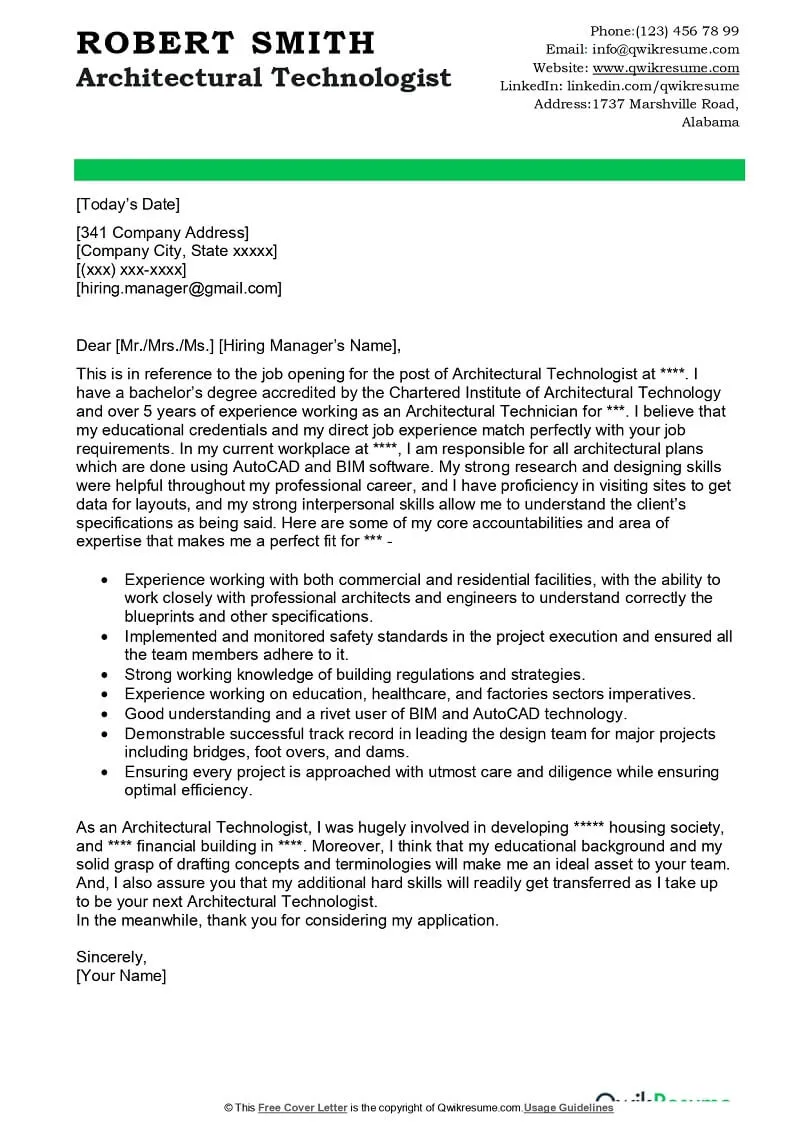Crafting a Compelling Architecture Student Cover Letter
As an architecture student, your cover letter is your first opportunity to make a strong impression on potential employers. It’s not just a formality; it’s a crucial tool for showcasing your passion, skills, and potential. A well-crafted cover letter can set you apart from other applicants and significantly increase your chances of landing an interview. This guide will provide you with the secrets to creating a cover letter that captivates, persuades, and ultimately, gets you noticed. We’ll explore the essential elements, from understanding its purpose to tailoring it for each specific application, ensuring you present yourself in the best possible light.
Understanding the Purpose of Your Cover Letter
The primary purpose of your architecture student cover letter is to introduce yourself and highlight your suitability for a specific position or internship. It’s a chance to tell a story that goes beyond your resume, providing context and demonstrating your personality, enthusiasm, and career aspirations. The cover letter should explain why you are interested in the firm, the role, and why your unique skills and experiences make you a perfect fit. Furthermore, it allows you to articulate your understanding of the company’s values and design philosophy, showing that you’ve done your research and are genuinely interested in contributing to their team. The goal is to convince the reader that you are not only qualified but also a good cultural fit.
Highlighting Your Architectural Skills
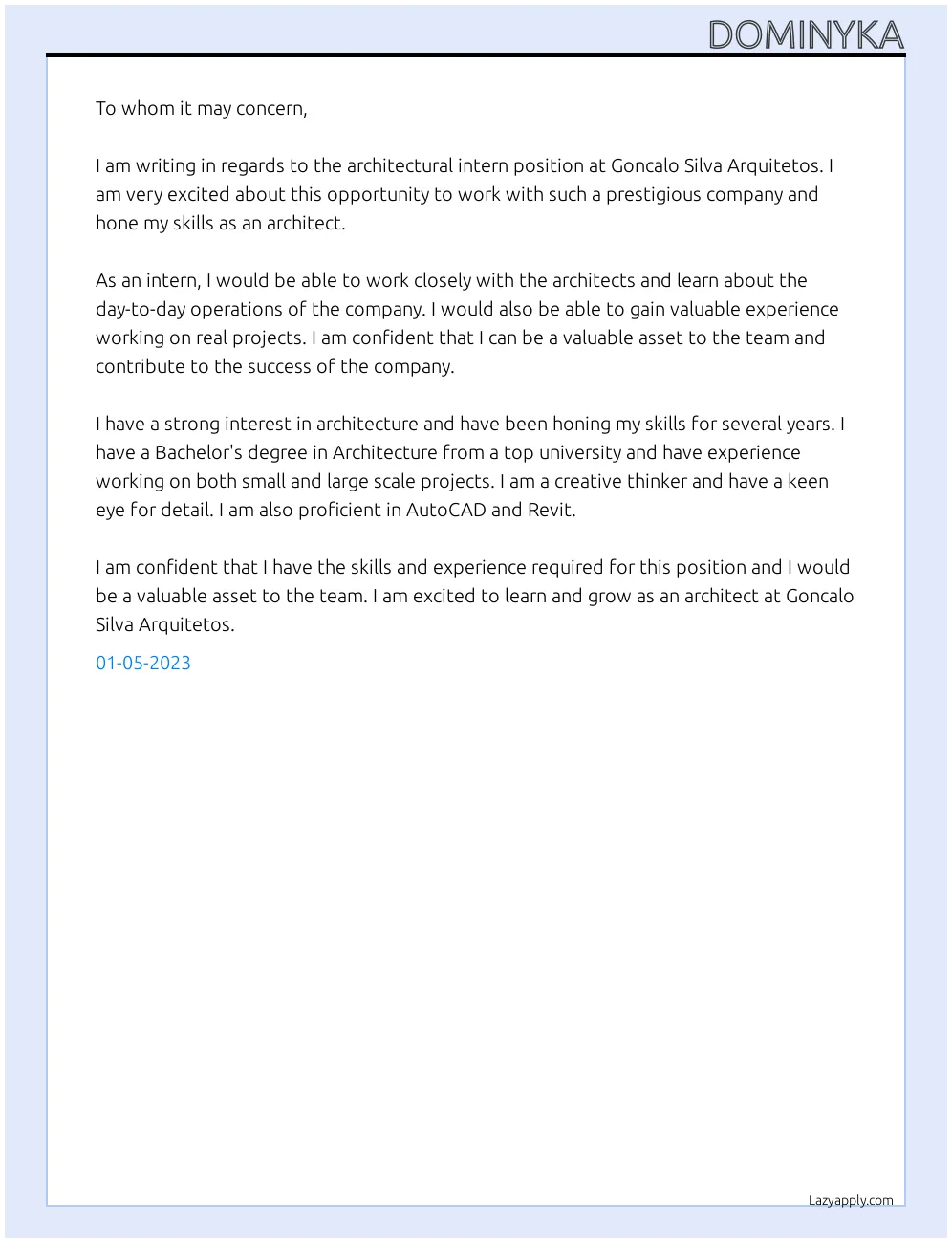
Your cover letter should clearly articulate your architectural skills, demonstrating your proficiency in relevant software, design principles, and technical knowledge. Be specific about the software you know such as AutoCAD, Revit, SketchUp, or other design tools. Showcase your understanding of design concepts such as space planning, building codes, and sustainable design practices. It’s important to connect your skills to the job description, emphasizing how they align with the firm’s needs and projects. For instance, if the firm specializes in residential design, highlight your experience with residential projects, your knowledge of relevant building codes, and your skills in creating detailed construction documents. This targeted approach shows that you’ve read the job description carefully and are ready to contribute from day one.
Showcasing Relevant Project Experience
Provide brief, impactful descriptions of your project experiences. These can be academic projects, internships, or any architectural work you’ve undertaken. Focus on the most relevant projects that align with the employer’s work. Briefly describe the project’s scope, your role, and the specific skills you utilized. Quantify your achievements whenever possible. Instead of saying ‘Assisted in the design of a new library’, provide a specific example like ‘Contributed to the design of a 20,000 sq ft library, utilizing sustainable design principles’. Mention any awards or recognitions received for your projects. Emphasize how your experience has prepared you for the role and how you can apply your skills to the firm’s current projects.
Formatting Your Architecture Student Cover Letter
A well-formatted cover letter is essential for making a professional impression. The format should be clean, easy to read, and visually appealing. Use a standard font like Times New Roman, Arial, or Calibri in a readable size (11 or 12 points). The margins should be one inch on all sides, and the text should be left-aligned with single spacing. Use concise paragraphs and bullet points to break up the text and make it more digestible. The goal is to create a document that is both informative and visually engaging, ensuring that the reader can easily follow your narrative and quickly grasp your key qualifications. A well-structured cover letter demonstrates attention to detail, a vital quality in architecture.
Contact Information and Header
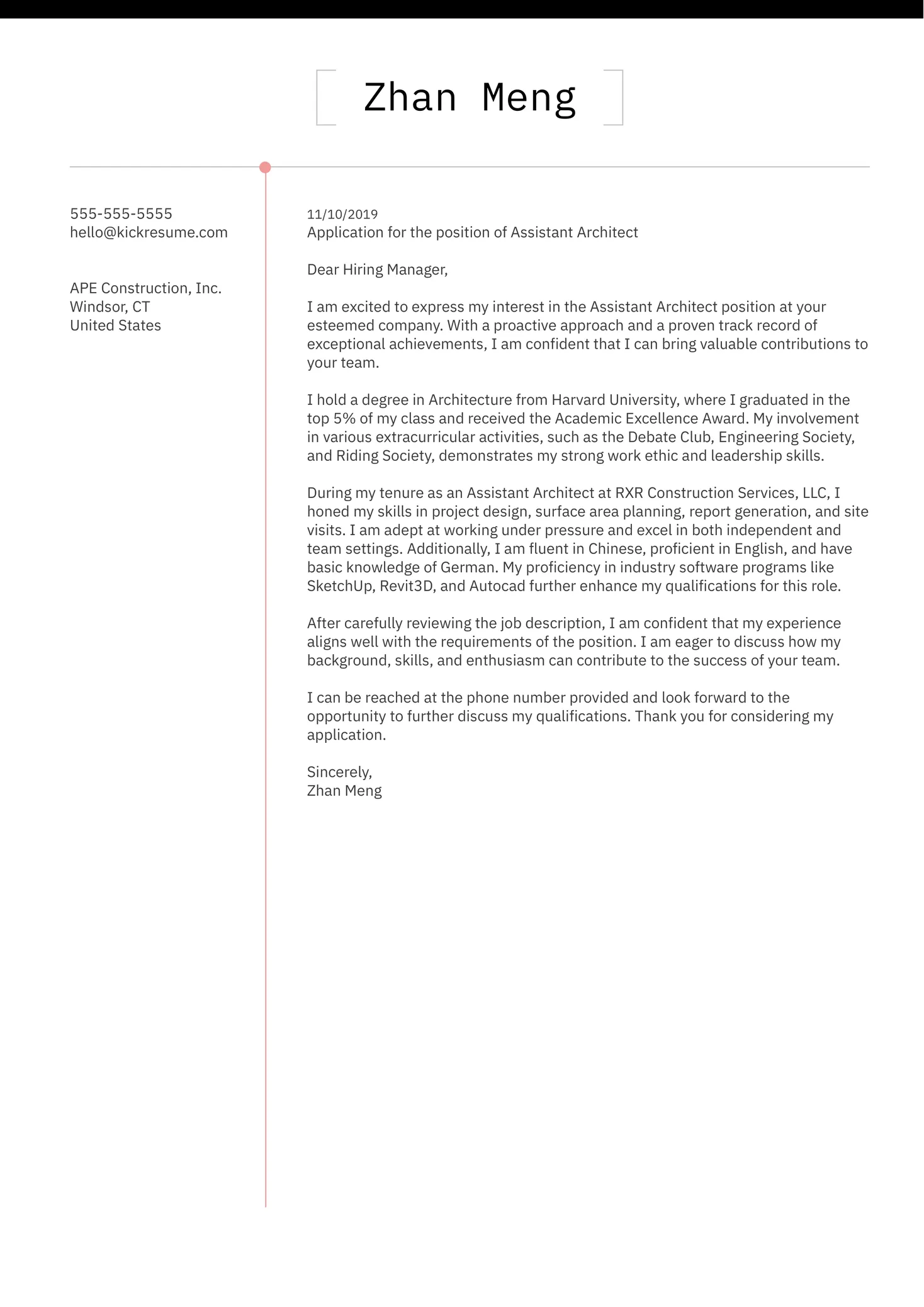
Your cover letter should begin with a professional header that includes your full name, address, phone number, and email address. This information should be clearly displayed at the top of the letter, making it easy for the employer to contact you. Also, include the date and the recipient’s contact information (name, title, company, and address). Ensure the recipient’s name and title are correct and accurately spelled. Addressing the letter to a specific person, rather than using a generic greeting like ‘To Whom It May Concern’, shows that you have researched the company and are genuinely interested in the opportunity. This personalization can make a significant impact on the reader.
Salutation and Addressing the Recipient
The salutation sets the tone for your cover letter. Use a formal and respectful greeting like ‘Dear Mr./Ms./Mx. [Last Name]’. If you are unsure of the recipient’s name or title, research the company website, LinkedIn, or call the company to find out. Avoid generic greetings such as ‘To Whom It May Concern’, as they lack personalization. If you are unable to find a specific contact, use a more general greeting like ‘Dear Hiring Manager’. In the body of your letter, address the recipient by name to maintain a professional and personal touch. This level of detail demonstrates your attention to detail and commitment to the application process.
Body Paragraph 1 Grabbing Attention
The first paragraph of your cover letter should grab the reader’s attention and clearly state the purpose of your letter. Begin by mentioning the specific position or internship you are applying for and where you saw the advertisement. Briefly introduce yourself and express your enthusiasm for the opportunity. State your interest in the company and mention something specific that drew you to them. This could be their design philosophy, a particular project, or their reputation in the industry. Make a strong first impression by demonstrating your research and highlighting your genuine interest. For example, ‘I am writing to express my keen interest in the Architectural Intern position at [Company Name], as advertised on [Platform].’
Body Paragraph 2 Demonstrating Skills and Experience
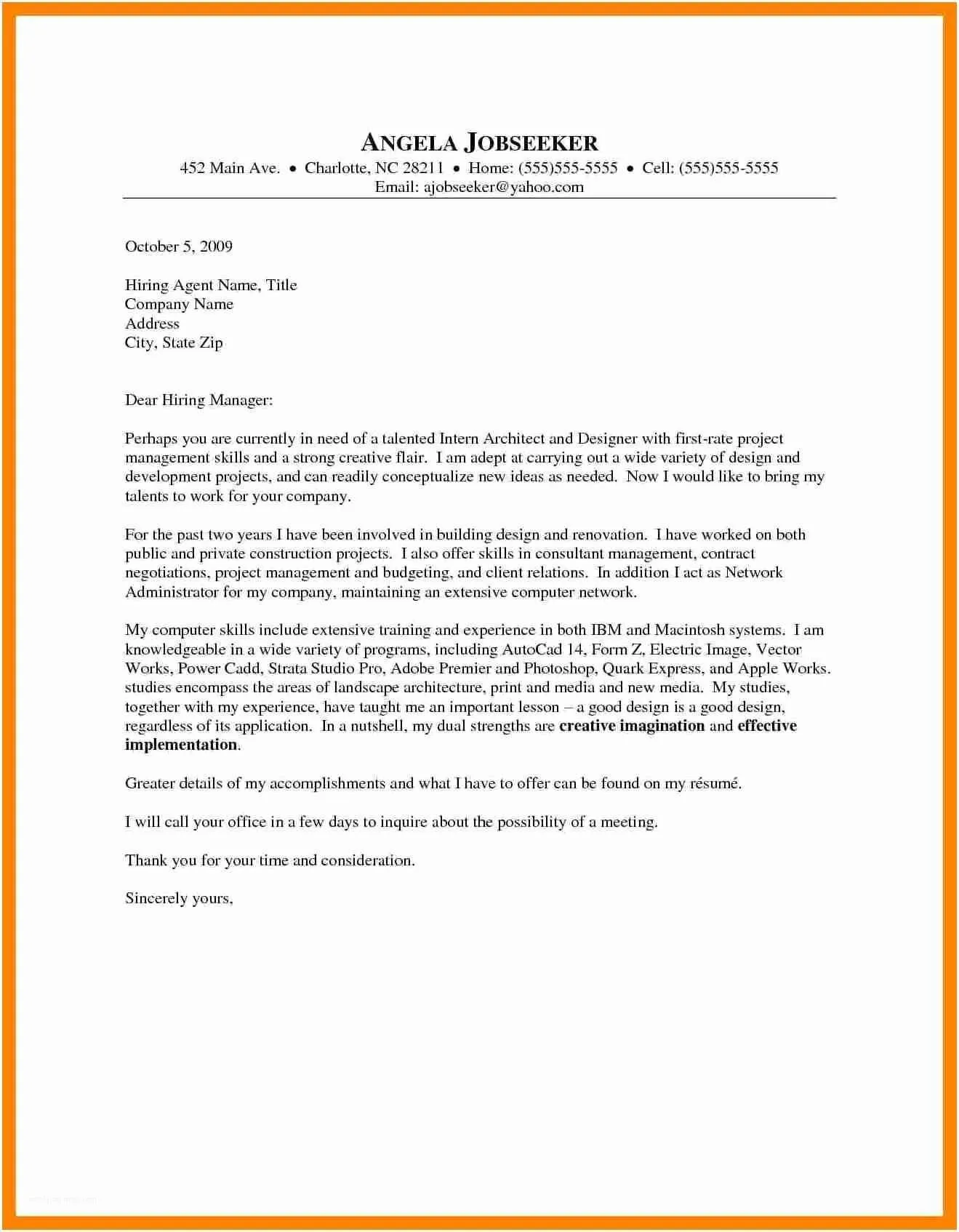
In the second paragraph, provide more detail about your skills and experience. Refer to your resume, but expand on your qualifications with specific examples. Highlight the skills that align with the job requirements. For example, if the job description mentions proficiency in Revit, mention your experience using the software on specific projects. Also, describe your role in projects, and what you learned, focusing on results and achievements. Explain how your skills and experience make you a good fit for the position, and provide a clear sense of how you can contribute to the company’s success. Back up your claims with concrete examples and quantify your achievements whenever possible to show the tangible impact of your skills.
Body Paragraph 3 Expressing Enthusiasm
The final body paragraph should express your enthusiasm for the opportunity and the company. Reiterate your interest in the position and the firm. Show that you understand the company’s values and design philosophy, and explain why you are excited about the prospect of working there. This is the perfect place to describe how the opportunity aligns with your career goals and aspirations. Mention any specific projects or aspects of the company that particularly excite you. By showcasing your passion and enthusiasm, you can make a lasting impression on the reader, demonstrating that you are not just looking for a job, but are truly motivated to contribute to the company’s success.
Closing and Call to Action
Conclude your cover letter with a strong call to action. Thank the reader for their time and consideration. Express your eagerness to discuss your qualifications further and reiterate your interest in the position. Provide your contact information once more, and state that you are available for an interview at their earliest convenience. End with a professional closing such as ‘Sincerely’ or ‘Best regards,’ followed by your name. This ensures a positive and professional end, and also reminds the reader to take the next step. This shows that you’re proactive and committed to the application process.
Proofreading and Editing Your Cover Letter
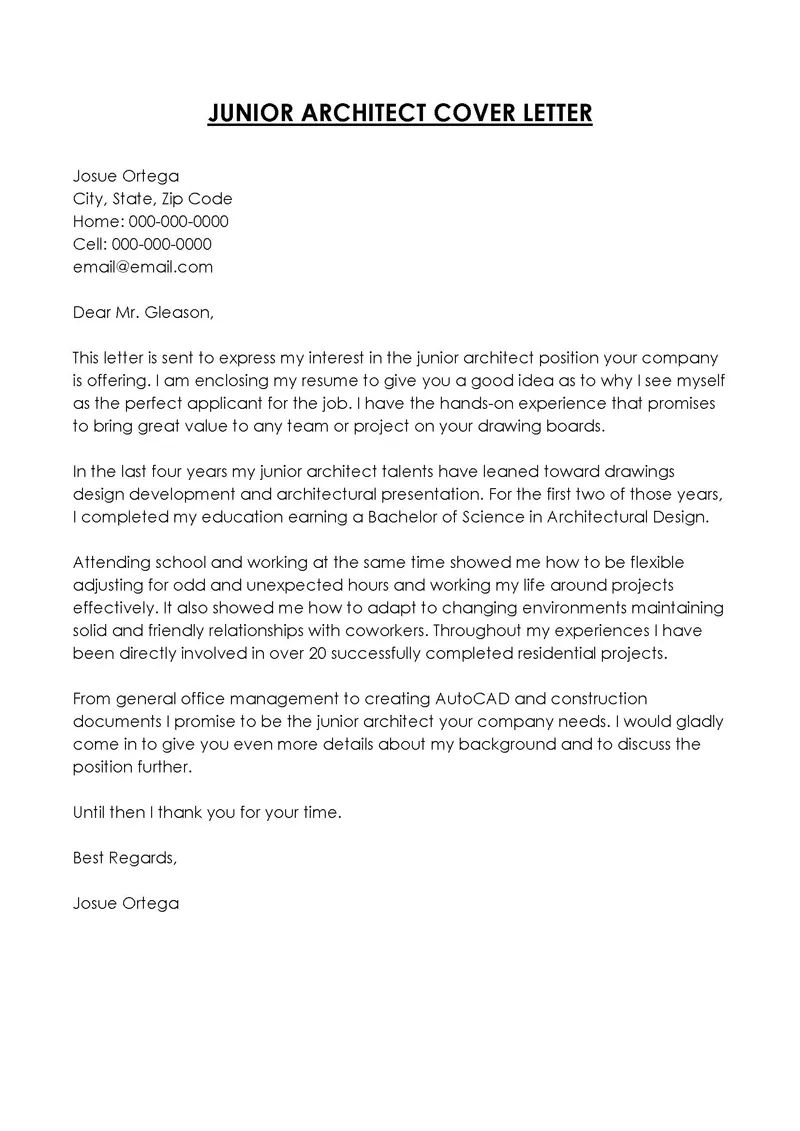
Proofreading and editing are crucial steps in the cover letter writing process. Errors, no matter how small, can detract from your professionalism and undermine your credibility. After writing your cover letter, take a break and review it with fresh eyes. Check for grammatical errors, spelling mistakes, and typos. Ensure that your sentences are clear, concise, and easy to understand. Read the letter aloud to catch any awkward phrasing. Ask a friend, professor, or career counselor to proofread your cover letter to get another perspective. Having a second pair of eyes can help you identify areas for improvement that you might have missed. A polished cover letter demonstrates your attention to detail, which is essential in architecture.
Common Mistakes to Avoid
Avoid common mistakes that can hurt your chances. Do not use generic or vague language. Be specific and provide concrete examples of your skills and experiences. Avoid simply restating your resume; use the cover letter to expand on your qualifications and tell a story. Do not use jargon that the reader may not understand. Use clear and concise language. Avoid sending a generic cover letter to multiple companies; personalize each letter for the specific role and company. Do not include irrelevant information that doesn’t support your candidacy. Always avoid negative language or criticizing previous employers or experiences. This creates a negative impression and can undermine your chances.
Using Action Verbs
Action verbs make your cover letter more dynamic and engaging. They add energy and convey your accomplishments in a clear and compelling way. Start your sentences with strong action verbs to showcase your abilities. For instance, instead of saying ‘Responsible for project management,’ write ‘Managed projects, ensuring deadlines and budgets were met.’ Other effective action verbs include designed, developed, created, implemented, collaborated, led, and achieved. Using action verbs effectively demonstrates your proactive approach and your ability to make a positive impact. Choose action verbs that accurately reflect your skills and experiences, providing a vivid and compelling narrative.
Tailoring Your Letter for Each Application
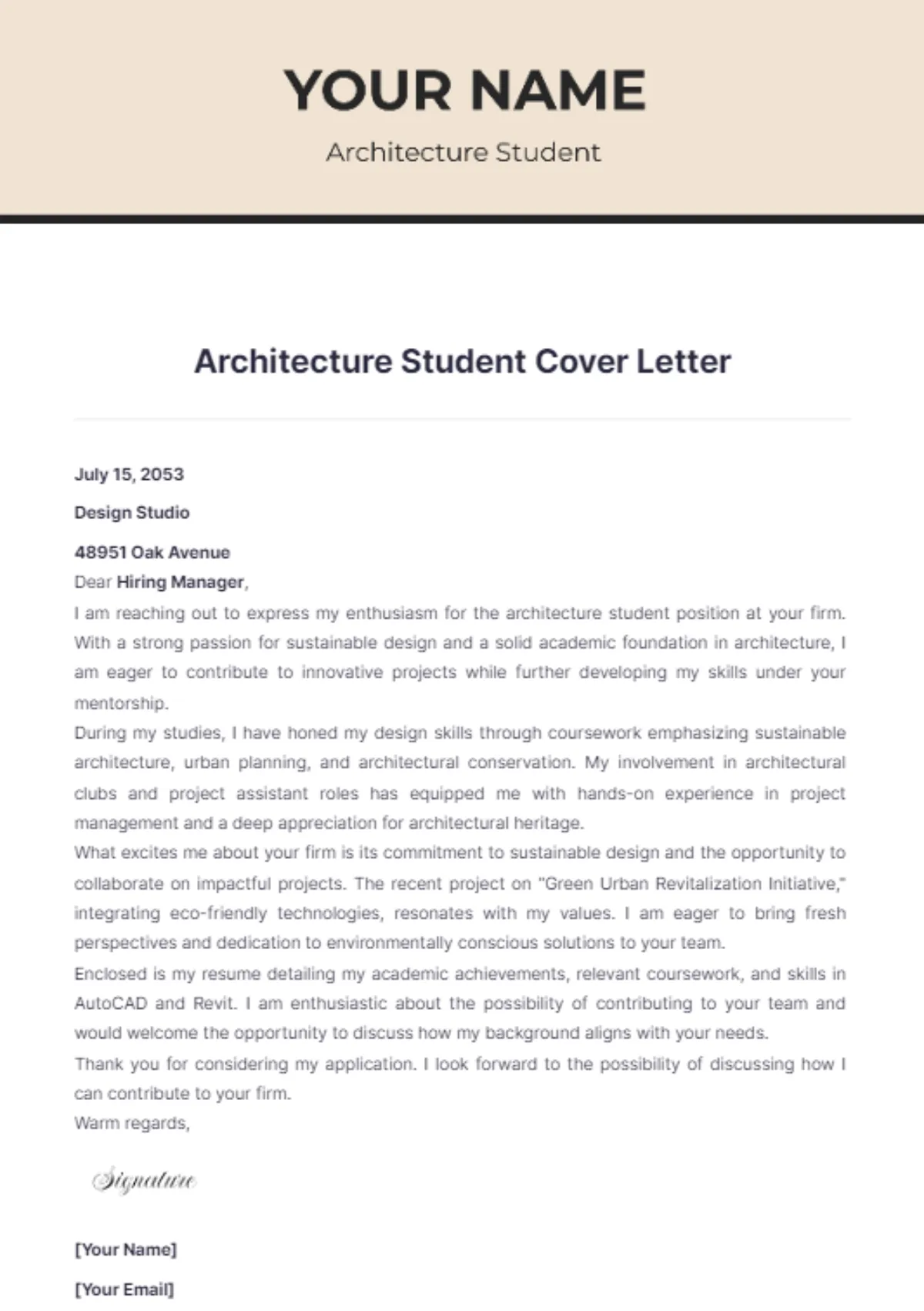
The most successful cover letters are tailored to each specific job application. Avoid using a generic template; instead, customize your letter for each position and company. Research the company and the specific role you are applying for. Identify the key requirements and skills the employer is seeking. Adjust your cover letter to highlight the most relevant skills and experiences. Mention specific projects or aspects of the company that interest you. Demonstrate your understanding of their values and design philosophy. Personalization shows that you are genuinely interested in the opportunity and have taken the time to understand the employer’s needs. Tailoring your cover letter also increases your chances of getting noticed.
In conclusion, crafting a compelling architecture student cover letter requires careful planning, thorough preparation, and attention to detail. By understanding the purpose of your cover letter, highlighting your skills and experience, and tailoring it for each application, you can significantly increase your chances of landing an interview. Proofread your letter carefully, use action verbs, and avoid common mistakes. Most importantly, showcase your passion for architecture and your enthusiasm for the opportunity. The secrets to a successful cover letter are: be authentic, be specific, and let your personality shine through. Use your cover letter as a tool to showcase your potential, demonstrate your value, and set yourself apart from the competition. With these strategies, you’ll be well on your way to securing your dream job in the world of architecture.
